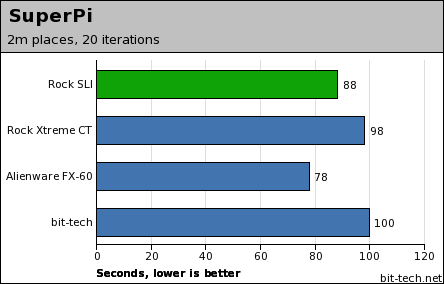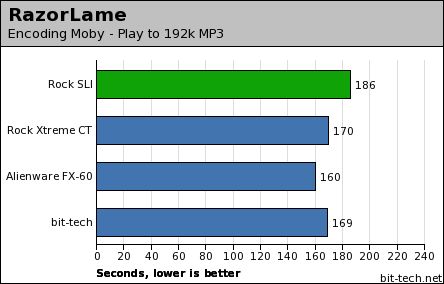General performance
We ranked the SLI notebook against a number of different systems. The first, and most obvious comparison, is against a desktop SLI system, so we ran it against the
Alienware SLI rig that we covered previously, which has two 512MB 7800 GTXs, an FX60 and 2GB RAM. The next obvious comparison is against the
17" Rock 7800 GTX notebook, which has a 2GHz Pentium M and 1GB RAM. We also compared it against our reference
bit-tech system. Provided by the kind folks at
Udiggit, our reference gaming system sports a 3800+ Athlon X2 chip, 2GB OCZ RAM, a 7800GT and is housed in a Shuttle SN25P.
Here, the Turion manages to edge out the Pentium M, showing that Intel doesn't have it all its own way in the mobile market. Obviously, it's soundly beaten by the FX-60, but interestingly, it's able to cane the X2 3800+ which is clocked 400MHz slower, since SuperPi isn't dual core enabled.
The superior bandwidth of desktop memory, thanks to faster timings and wider buses, pays off here.
The Turion processor produces the slowest time in the MP3 encoding test but in general, the system performance is fairly consistently good.
Gaming performance
Here, we tested the Rock notebook in both single card and SLI configurations, to get an idea of the scaling of SLI on portables.
Obviously, the 512MB cards own the field here, but it's clear that SLI works, and is damn fast in this machine; in fact, it is double the speed of a single Go 7800 GTX with the same system specifications.
SLI doesn't add much to this title, but the results all scale as you'd expect.
Since SLI gives you 512MB of memory, you can happily load up Ultra quality in Doom 3 and get decent framerates.
















Want to comment? Please log in.